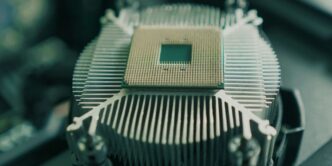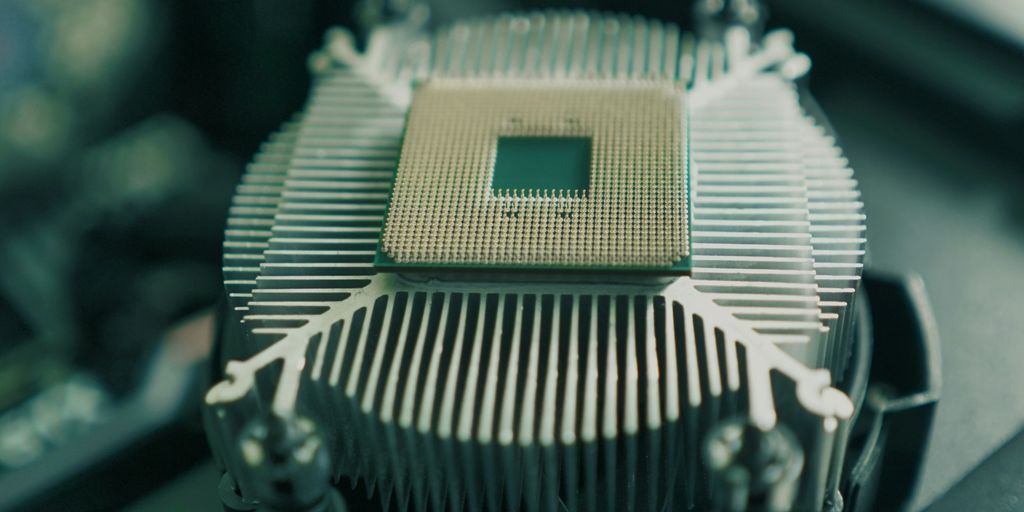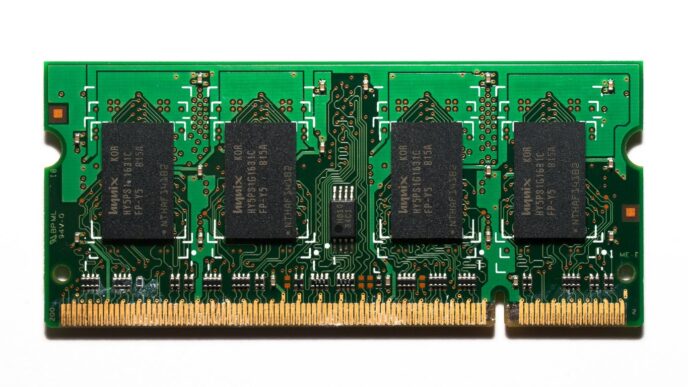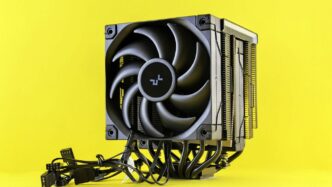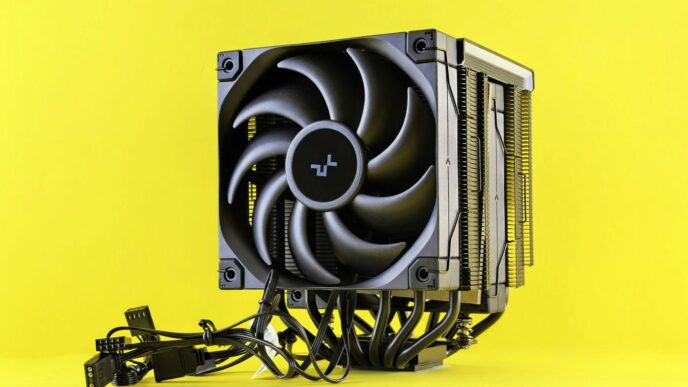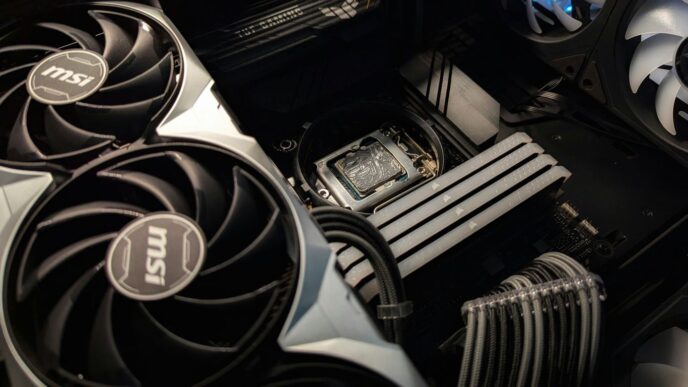Alright, so you’re probably wondering, which processor should you go with? Ryzen or Intel? It’s a question that pops up a lot, and honestly, it’s a pretty big deal when you’re building a new computer or just trying to figure out what’s best for your work. Both companies are always pushing the limits, trying to one-up each other, which is great for us, the users. As we head into 2025, things are getting even more interesting. We’re talking about new designs, better ways of making these chips, and even more smart features built right in. So, let’s break it down and see what’s what with ryzen vs intel, and help you decide which one might be the champion for you next year.
Key Takeaways
- Both Intel and AMD are constantly improving their chip designs, with Intel focusing on hybrid architectures and AMD on its Zen line.
- Single-core performance is still a battleground, with Intel often having a slight edge in clock speeds, but Ryzen’s special tech is closing the gap.
- For tasks needing lots of cores, Ryzen usually pulls ahead, making it a good pick for creative work.
- Choosing a processor in 2025 will depend a lot on what you do most, like gaming, creating stuff, or just everyday computer use.
- The competition between these two tech giants means better products and prices for everyone, whether you’re a regular user or a big company.
The Evolving Desktop Battlefield: What to Expect in 2025
By 2025, the desktop processor market will be a hotbed of innovation as both Intel and AMD push the limits of core counts, clock speeds, and integrated features. It’s going to be a wild ride! Choosing the right processor will be more important than ever. Let’s take a look at what we can expect from both companies.
Intel’s Hybrid Architecture Refinements
Intel is expected to continue refining its hybrid architecture. We’re talking about the next-generation "Arrow Lake" or "Lunar Lake" chips. The focus will be on balancing high-performance P-cores with power-efficient E-cores. This means better performance for demanding tasks and improved efficiency for background processes. Intel will also likely put a lot of effort into improving its integrated graphics and AI capabilities. Maybe we’ll see more powerful NPUs (Neural Processing Units) directly on the CPU, which would be awesome for gaming and content creation. It’s all about integrated graphics these days.
AMD’s Zen Architecture Momentum
AMD is expected to release its Zen 5 architecture, and maybe even a sneak peek at Zen 6. Known for strong multi-core performance and gaming, especially with 3D V-Cache, AMD will try to keep or increase its lead in these areas. Expect more innovation in chiplet design, allowing for greater scalability and specialized cache configurations. The competition will be fierce, with both companies trying to offer the best performance for the money, especially in the mid-range and high-end gaming segments. AMD is really pushing the boundaries with Zen architecture.
Integrated Graphics and AI Capabilities
Both Intel and AMD will be focusing on integrated graphics and AI. This means better performance for tasks like video editing, gaming, and even everyday tasks. We might see dedicated AI accelerators (NPUs) on the CPU, which would be a game-changer. It’s all about making the CPU more versatile and efficient. The advancements in AI capabilities are going to be huge.
Architectural Advancements Driving Performance
It’s 2025, and the processor landscape is more exciting than ever! Both AMD and Intel are pushing the boundaries of what’s possible, and it’s all thanks to some serious architectural innovation. Let’s take a look at what’s driving performance in these next-gen chips.
AMD’s Zen 5 and 3D V-Cache Technology
AMD is expected to continue its focus on the Zen architecture, with Zen 5 leading the charge. We might even see a sneak peek at Zen 6! A key area of improvement is expected to be in multi-core performance and gaming, building upon their success with 3D V-Cache technology. This tech stacks extra cache on top of the processor die, which can seriously boost gaming frame rates. AMD’s chiplet design also allows for great scalability, letting them pack more cores into their CPUs. This is great for tasks that can use a lot of processing power, like video editing.
Intel’s Core i9 Hybrid Design
Intel is doubling down on its hybrid architecture, which combines Performance-cores (P-cores) and Efficient-cores (E-cores). The idea is to have P-cores handle the heavy lifting, while E-cores take care of background tasks and improve power efficiency. The next generation of Core i9 processors are expected to bring significant improvements to both P-cores and E-cores, leading to snappier performance in everyday tasks and more power for demanding workloads. It’s a smart approach to balancing performance and power consumption.
Next-Generation Manufacturing Processes
The race to smaller manufacturing nodes is also a big deal. Moving to 3nm or even 2nm processes allows for more transistors to be packed onto a single chip, leading to higher speeds and better power efficiency. Both AMD and Intel are working hard to adopt these new processes, which will be crucial for AI acceleration and enabling the next generation of processor performance. It’s a constant push to make things smaller, faster, and more efficient. The competition is fierce, and that’s good news for consumers!
Single-Core Performance Showdown
Intel’s Clock Speed Advantage
Okay, so when it comes to raw speed, Intel has usually been the king. They’ve pushed their clock speeds pretty high, and that gives them an edge in tasks that only use one core. Think about older games or some specific applications that aren’t really built to take advantage of multiple cores. Intel’s ability to crank up the GHz often translates to snappier performance in those situations. It’s not always about having the most cores; sometimes, it’s about how fast each core can go.
Ryzen’s Zen 5 and V-Cache Impact
But don’t count AMD out! With their Zen 5 architecture and that fancy 3D V-Cache, they’re really closing the gap. The V-Cache is like giving the processor a bigger playground to store frequently used data, which can seriously speed things up. It’s like having all your favorite toys right next to you instead of having to run to the toy box every time. Plus, Zen 5 brings its own set of improvements that make each core more efficient. AMD is making a strong case for single-core performance, even if they aren’t always winning the clock speed battle. The AMD Ryzen processors are becoming a close competitor of Intel in many cases.
Optimized Architectures for Responsiveness
Ultimately, it’s not just about clock speed or cache size. It’s about how well the entire architecture is optimized. Both Intel and AMD are constantly tweaking their designs to get the most out of every cycle. This means things like:
- Better branch prediction (guessing what the processor will do next).
- Improved instruction pipelines (lining up tasks more efficiently).
- Smarter memory controllers (getting data in and out faster).
These optimizations can have a huge impact on how responsive a system feels, even if the clock speeds aren’t dramatically different. It’s like tuning a car engine – you can get more power without just making it bigger. The single core performance is a key metric, especially when it comes to high end tasks like gaming.
Multi-Core Performance for Demanding Workloads
When it comes to tasks that really push a processor to its limits, like video editing, 3D rendering, or scientific simulations, multi-core performance is where it’s at. It’s not just about having a fast clock speed; it’s about how many cores and threads a processor can throw at a problem simultaneously. Let’s break down how AMD and Intel are shaping up in this area for 2025.
Ryzen’s Core and Thread Dominance
AMD has been making waves with its Ryzen processors, especially in multi-core performance. They’ve packed more cores and threads into their CPUs, which translates to better performance in heavily threaded applications. This is a big deal for content creators and professionals who rely on these kinds of workloads. Think about rendering a complex 3D scene – the more cores you have, the faster it gets done. AMD’s Zen architecture is designed to scale well with increasing core counts, giving them an edge in these scenarios. For example, the AMD Ryzen™ 9 9950X is a beast when it comes to multi-core workloads.
Intel’s Efficiency Cores in Multi-Threading
Intel’s approach is a bit different. With their hybrid architecture, they’re combining high-performance P-cores with efficiency-focused E-cores. The idea is that the P-cores handle the main tasks, while the E-cores take care of background processes and multi-threading. It’s an interesting strategy, but the key is how well the operating system and applications can manage these different core types. If everything works smoothly, Intel could offer a good balance of performance and power efficiency. Intel will emphasize its robust ecosystem, established enterprise relationships, and specialized instruction sets or accelerators (like AMX for AI) to cater to specific enterprise needs, from AI and HPC to cloud computing and database management. Reliability, security features, and platform stability will remain key selling points.
Ideal Processors for Content Creation
So, which processor is better for content creation? Well, it depends. If you’re doing a lot of heavy rendering or simulations, AMD’s Ryzen processors with their high core counts are likely the way to go. But if you’re doing a mix of tasks, and you value things like quick video encoding (which Intel’s Quick Sync excels at), then Intel’s hybrid approach might be a better fit. Ultimately, it comes down to your specific needs and how well the software you use can take advantage of each processor’s strengths. The difference between Ryzen and Intel in multi-core performance is a key factor for professionals.
Making Your Choice: Navigating the 2025 Processor Maze
Okay, so it’s 2025, and you’re staring down a wall of processors, trying to figure out which one is right for you. It can be overwhelming! Both AMD and Intel are constantly pushing out new tech, and it’s not always clear which chip is the best fit. Let’s break it down into some common use cases to make the decision a little easier.
Processor Selection for Gamers
For gamers, the choice is going to depend a lot on the specific games you play and the resolution you’re targeting. Frame rates are king, so single-core performance and how well the CPU plays with your graphics card are super important. Here’s a quick rundown:
- Check benchmarks for your favorite games. See which CPUs consistently deliver higher frame rates.
- Consider the resolution you play at. Higher resolutions often shift the bottleneck to the GPU, making the CPU less critical.
- Look for CPUs with strong single-core performance, as many games still rely heavily on a single core.
Processor Selection for Content Creators
Content creation is where things get interesting. Video editing, 3D rendering, and other creative tasks benefit from having a lot of cores and threads. But it’s not just about raw power; software optimization matters too. For example, top tech stocks can influence hardware development.
- Prioritize multi-core performance. The more cores, the faster you can render videos or compile code.
- Check if your software is optimized for AMD or Intel. Some applications may perform better on one platform than the other.
- Consider Intel’s Quick Sync Video technology for video encoding, as it can significantly speed up the process.
Processor Selection for General Users
For everyday tasks like browsing the web, writing emails, and streaming videos, you don’t need a super-powerful processor. A mid-range CPU from either AMD or Intel will be more than enough. The key here is to find a balance between price, performance, and features. Don’t overspend on a CPU you don’t need.
- Focus on value. Get the most performance for your money.
- Consider integrated graphics. If you’re not a gamer, you don’t need a dedicated graphics card.
- Look for features like Wi-Fi 7 and fast USB ports for a better overall experience.
Server Deployments: EPYC vs. Xeon in 2025

The server market is a high-stakes game, and by 2025, the competition between AMD’s EPYC and Intel’s Xeon processors will be fiercer than ever. Both companies are pushing the limits of performance and efficiency to win over data centers and cloud providers. It’s a battle of core counts, power efficiency, and specialized features, with customers reaping the benefits of this intense rivalry.
AMD EPYC’s Core Density for Cloud and Virtualization
AMD EPYC processors have made a name for themselves by packing a ton of cores into a single chip. By 2025, this advantage will likely be even more pronounced. More cores mean better performance for cloud computing and virtualization, where workloads can be easily distributed across multiple threads. EPYC’s architecture is well-suited for these tasks, offering excellent scalability and memory bandwidth. Think of it like having a lot of workers on a construction site – the more workers, the faster the building goes up. AMD will continue to focus on performance-per-watt and TCO, making them a compelling choice for data centers looking to reduce costs.
Intel Xeon’s Specialization for HPC and AI
Intel isn’t sitting still. They’re expected to continue their two-pronged approach with Xeon processors: high-performance P-core based Xeons for compute-intensive workloads and high-density E-core based Xeons for efficiency and scale-out applications. Intel will emphasize its robust ecosystem, established enterprise relationships, and specialized instruction sets or accelerators (like AMX for AI) to cater to specific enterprise needs, from AI and HPC to cloud computing and database management. Intel’s Xeon processors are often optimized for specific tasks, such as high-performance computing (HPC) and artificial intelligence (AI). They might include specialized hardware or instructions that accelerate these workloads. It’s like having specialized tools for specific jobs – a carpenter wouldn’t use a hammer to screw in a screw, and Intel wouldn’t use a general-purpose processor for AI training.
Scalability and Efficiency in Data Centers
Ultimately, the choice between EPYC and Xeon will depend on the specific needs of the data center. Both processors offer excellent scalability, allowing data centers to easily add more computing power as needed. However, they differ in their approach to efficiency. AMD focuses on packing more cores into a smaller power envelope, while Intel balances performance and efficiency with its hybrid architecture. Data centers will need to carefully consider their workloads and power constraints when making their decision. Here’s a quick comparison:
| Feature | AMD EPYC | Intel Xeon |
|---|---|---|
| Core Density | High | Moderate to High |
| Specialization | General-purpose, excellent for virtualization | Specialized for HPC and AI |
| Power Efficiency | Excellent | Good |
The Impact of Innovation on Pricing and Features
Competitive Pricing Strategies
Okay, so by 2025, expect the gloves to be OFF when it comes to pricing. Both AMD and Intel will be fighting tooth and nail for your hard-earned cash. AMD will likely keep pushing its value proposition, especially for those who need a ton of cores without breaking the bank. Intel? They might still have a bit of a premium, but they’ll need to justify it with features and performance. It’s going to be a fun time for consumers looking for the best deals on CPUs.
Enhanced Features for Consumers
It’s not just about raw power anymore. We’re talking about cool features that make your life easier. Think better integrated graphics, maybe even more powerful AI stuff built right into the CPU for AI acceleration. Both companies will be trying to one-up each other with things like improved video encoding, better memory support (hello, DDR6!), and faster connectivity. Basically, expect your processor to do more than just crunch numbers; it’ll be a whole entertainment and productivity hub.
Benefits of Intense Processor Rivalry
Honestly, the best part about AMD and Intel constantly trying to outdo each other is that we, the consumers, win. We get better processors, cooler features, and more competitive prices. It pushes both companies to innovate faster and harder. It’s like they’re in a never-ending race, and we’re all just sitting on the sidelines, cheering them on and reaping the rewards. So, bring on the intense processor rivalry, I say!
Wrapping It Up: Who Wins the CPU Battle?
So, after looking at all this, who’s the big winner in the Ryzen vs. Intel fight for 2025? Honestly, it’s not a simple answer. Both companies are really pushing things forward, which is awesome for us, the folks buying these chips. Intel’s got some cool stuff going on with their hybrid designs, trying to get back on top. And AMD, well, they’re just keeping that Zen architecture momentum going, really challenging the old guard. This whole back-and-forth means we get better tech, more features, and probably better prices too. It’s a good time to be building a PC or upgrading your setup, that’s for sure.
Frequently Asked Questions
Which processor is better, Intel or AMD, in 2025?
Picking between Intel and AMD in 2025 will depend on what you need it for. Both companies are making really good processors. If you play a lot of games, you’ll want to check which one runs your favorite games better. If you create videos or do other big projects, you’ll need one that handles many tasks at once. For everyday stuff, either one will likely work great.
Which processor is best for gaming in 2025?
For gaming, it really depends on the specific game. Sometimes Intel’s high speed is best, and sometimes AMD’s special memory tech (3D V-Cache) gives it an edge. You’ll want to look at recent tests for the games you play.
Which processor is better for creative work like video editing in 2025?
For tasks like making videos or 3D designs, processors that can do many things at once are usually better. AMD’s Ryzen chips often have more cores, which are like mini-brains, making them strong for these jobs. Intel also has good options with their hybrid design that uses different types of cores for different tasks.
What new technologies can we expect from Intel and AMD in 2025?
Both companies are always trying to make their processors faster and better. They are working on new ways to build the chips, like making parts smaller and adding special sections for AI. This competition means we get better and better computers.
How will Intel and AMD processors be different in 2025?
Intel is focusing on making its hybrid processors even better, where some parts are for speed and others for saving power. AMD is building on its Zen architecture, making it faster and more efficient. Both are also putting more effort into graphics and AI features right inside the processor.
How does the competition between Intel and AMD benefit consumers?
The fight between Intel and AMD helps us all because it pushes both companies to innovate more. This means they release new features faster, make processors more powerful, and sometimes even lower prices to stay competitive. So, we get better products for our money.

